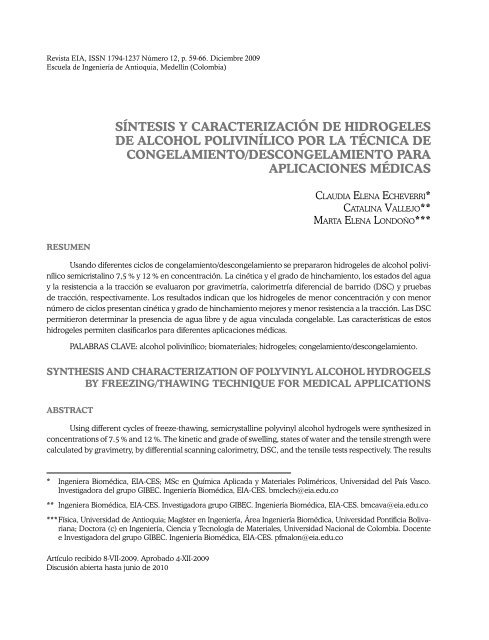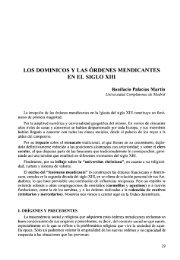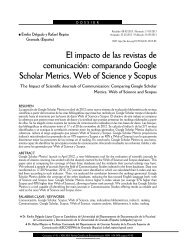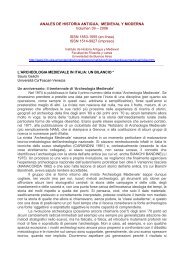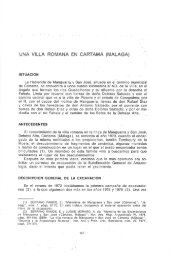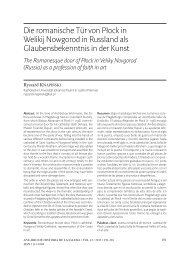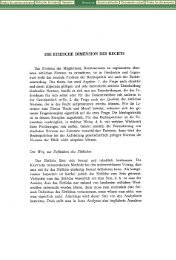síntesis y caracterización de hidrogeles de alcohol ... - Dialnet
síntesis y caracterización de hidrogeles de alcohol ... - Dialnet
síntesis y caracterización de hidrogeles de alcohol ... - Dialnet
Create successful ePaper yourself
Turn your PDF publications into a flip-book with our unique Google optimized e-Paper software.
Revista EIA, ISSN 1794-1237 Número 12, p. 59-66. Diciembre 2009<br />
Escuela <strong>de</strong> Ingeniería <strong>de</strong> Antioquia, Me<strong>de</strong>llín (Colombia)<br />
RESUMEN<br />
SÍNTESIS Y CARACTERIZACIÓN DE HIDROGELES<br />
DE ALCOHOL POLIVINÍLICO POR LA TÉCNICA DE<br />
CONGELAMIENTO/DESCONGELAMIENTO PARA<br />
APLICACIONES MÉDICAS<br />
Artículo recibido 8-VII-2009. Aprobado 4-XII-2009<br />
Discusión abierta hasta junio <strong>de</strong> 2010<br />
Claudia ElEna EChEvErri*<br />
Catalina vallEjo**<br />
Marta ElEna londoño***<br />
Usando diferentes ciclos <strong>de</strong> congelamiento/<strong>de</strong>scongelamiento se prepararon <strong>hidrogeles</strong> <strong>de</strong> <strong>alcohol</strong> polivinílico<br />
semicristalino 7,5 % y 12 % en concentración. La cinética y el grado <strong>de</strong> hinchamiento, los estados <strong>de</strong>l agua<br />
y la resistencia a la tracción se evaluaron por gravimetría, calorimetría diferencial <strong>de</strong> barrido (DSC) y pruebas<br />
<strong>de</strong> tracción, respectivamente. Los resultados indican que los <strong>hidrogeles</strong> <strong>de</strong> menor concentración y con menor<br />
número <strong>de</strong> ciclos presentan cinética y grado <strong>de</strong> hinchamiento mejores y menor resistencia a la tracción. Las DSC<br />
permitieron <strong>de</strong>terminar la presencia <strong>de</strong> agua libre y <strong>de</strong> agua vinculada congelable. Las características <strong>de</strong> estos<br />
<strong>hidrogeles</strong> permiten clasificarlos para diferentes aplicaciones médicas.<br />
PALABRAS CLAVE: <strong>alcohol</strong> polivinílico; biomateriales; <strong>hidrogeles</strong>; congelamiento/<strong>de</strong>scongelamiento.<br />
SYNTHESIS AND CHARACTERIZATION OF POLYVINYL ALCOHOL HYDROGELS<br />
BY FREEZING/THAWING TECHNIQUE FOR MEDICAL APPLICATIONS<br />
ABSTRACT<br />
Using different cycles of freeze-thawing, semicrystalline polyvinyl <strong>alcohol</strong> hydrogels were synthesized in<br />
concentrations of 7.5 % and 12 %. The kinetic and gra<strong>de</strong> of swelling, states of water and the tensile strength were<br />
calculated by gravimetry, by differential scanning calorimetry, DSC, and the tensile tests respectively. The results<br />
* Ingeniera Biomédica, EIA-CES; MSc en Química Aplicada y Materiales Poliméricos, Universidad <strong>de</strong>l País Vasco.<br />
Investigadora <strong>de</strong>l grupo GIBEC. Ingeniería Biomédica, EIA-CES. bmclech@eia.edu.co<br />
** Ingeniera Biomédica, EIA-CES. Investigadora grupo GIBEC. Ingeniería Biomédica, EIA-CES. bmcava@eia.edu.co<br />
*** Física, Universidad <strong>de</strong> Antioquia; Magíster en Ingeniería, Área Ingeniería Biomédica, Universidad Pontificia Bolivariana;<br />
Doctora (c) en Ingeniería, Ciencia y Tecnología <strong>de</strong> Materiales, Universidad Nacional <strong>de</strong> Colombia. Docente<br />
e Investigadora <strong>de</strong>l grupo GIBEC. Ingeniería Biomédica, EIA-CES. pfmalon@eia.edu.co
60<br />
SínteSiS y <strong>caracterización</strong> <strong>de</strong> hidrogeleS <strong>de</strong> <strong>alcohol</strong> polivinílico...<br />
show that hydrogels with less concentration and cycles have better gra<strong>de</strong> and kinetic of swelling, while the tensile<br />
strength is lower. The DSC results allow us to <strong>de</strong>termine the free and freezable bound waters in our hydrogels.<br />
The characteristics obtained from these hydrogels lead their classification for different medical applications.<br />
KEY WORDS: polyvinyl <strong>alcohol</strong>; biomaterials; hydrogels; freezing/thawing.<br />
SÍNTESES E CARACTERIZAÇÃO DE HIDROGEIS DE ÁLCOOL POLIVINÍLICO<br />
PELA TÉCNICA DE CONGELAMENTO/DESCONGELAMENTO PARA<br />
APLICAÇÕES MÉDICAS<br />
RESUMO<br />
Usando diferentes ciclos <strong>de</strong> congelamento/<strong>de</strong>scongelamento se prepararam hidrogéis <strong>de</strong> álcool polivinílico<br />
semicristalino 7,5 % e 12 % em concentração. A cinética e o grau <strong>de</strong> inchamento, os estados da água e a<br />
resistência à tração se avaliaram por gravimetria, calorimetria diferencial <strong>de</strong> varrido (DSC) e provas <strong>de</strong> tração,<br />
respectivamente. Os resultados indicam que os hidrogeis <strong>de</strong> menor concentração e com menor número <strong>de</strong> ciclos<br />
apresentam cinética e grau <strong>de</strong> inchamento melhores e menor resistência à tração. As DSC permitiram <strong>de</strong>terminar<br />
a presença <strong>de</strong> água livre e <strong>de</strong> agua ligada congelável. As características <strong>de</strong>stes hidrogeis permitem classificá-los<br />
para diferentes aplicações médicas.<br />
PALAVRAS-CÓDIGO: álcool polivinílico; biomateriais; hidrogeis; congelamento/<strong>de</strong>scongelamento.<br />
1. INTRODUCCIÓN<br />
Durante las últimas décadas se ha estudiado<br />
una nueva clase <strong>de</strong> materiales <strong>de</strong>nominados <strong>hidrogeles</strong>,<br />
los cuales son re<strong>de</strong>s poliméricas tridimensionales<br />
capaces <strong>de</strong> absorber líquidos (agua o fluidos corporales)<br />
sin disolverse y liberarlos con el tiempo (Yoshii<br />
et al., 1995; Hassan y Peppas, 2000a, 2000b; Schacht,<br />
2004; Li, Luo y Lam, 2007; Nugent y Higginbotham,<br />
2007). Esta característica, junto con su biocompatibilidad<br />
con los tejidos humanos, permeabilidad y<br />
bajo coeficiente <strong>de</strong> fricción (Stammen et al., 2001),<br />
los ha hecho aptos para ser usados en aplicaciones<br />
médicas (Lapidot y Kost, 2001; Hoffman, 2002). Estas<br />
re<strong>de</strong>s tridimensionales están compuestas por una fase<br />
sólida, fluido intersticial y especies iónicas; se les ha<br />
consi<strong>de</strong>rado como biomateriales inteligentes, ya que<br />
algunos <strong>de</strong> ellos respon<strong>de</strong>n variando su volumen a<br />
estímulos <strong>de</strong>l medio ambiente tales como cambios<br />
<strong>de</strong> pH, temperatura, concentración <strong>de</strong> especies,<br />
radiaciones, entre otros (Kim et al., 2002, Nugent y<br />
Higginbotham, 2007).<br />
Los <strong>hidrogeles</strong> se pue<strong>de</strong>n obtener a partir <strong>de</strong><br />
polímeros naturales, por ejemplo, colágeno, quitosán,<br />
fibrina y otros, y sintéticos (óxido <strong>de</strong> polietileno,<br />
ácido poliacrílico, polivinil pirrolidona y <strong>alcohol</strong> polivinílico)<br />
(El Fray et al., 2007), por medio <strong>de</strong> procesos<br />
físicos y químicos. El tipo <strong>de</strong> proceso elegido para<br />
la <strong>síntesis</strong> <strong>de</strong> estos materiales <strong>de</strong>termina sus propieda<strong>de</strong>s.<br />
Las técnicas <strong>de</strong> procesamiento físicas tienen<br />
la ventaja <strong>de</strong> no requerir agentes entrecruzantes<br />
químicos, los cuales son tóxicos y hacen necesario<br />
realizar varios lavados al hidrogel hasta asegurar que<br />
dicha toxicidad haya <strong>de</strong>saparecido (Hassan y Peppas,<br />
2000a, 2000b).<br />
Los <strong>hidrogeles</strong> se han aplicado en un amplio<br />
espectro <strong>de</strong> áreas, tales como medicina, biotecnología,<br />
farmacia e industria (Vallejo et al., 2005; Lin y<br />
Metters, 2006). Se han empleado como sistemas <strong>de</strong><br />
Revista EIA
suministro <strong>de</strong> medicamentos, apósitos húmedos, matrices<br />
para el cultivo <strong>de</strong> células, lentes <strong>de</strong> contacto,<br />
sensores, como reemplazo <strong>de</strong> tendones, piel, ligamentos<br />
y cartílago, entre muchas otras aplicaciones<br />
(Stammen, 2001).<br />
El <strong>alcohol</strong> polivinílico o polivinil <strong>alcohol</strong>, PVA,<br />
es un polímero hidrofílico, no tóxico, biocompatible,<br />
con buenas propieda<strong>de</strong>s mecánicas y muy estable<br />
durante largos períodos en diferentes condiciones<br />
<strong>de</strong> temperatura y pH (Gholap, Jog y Badiger,<br />
2004). A partir <strong>de</strong> este polímero se pue<strong>de</strong>n obtener<br />
<strong>hidrogeles</strong> por entrecruzamiento físico o químico<br />
(Hassan y Peppas, 2000a, 2000b; Pan, Xiong y Ma,<br />
2006; Nakaoki y Yamashita, 2008; Xiao y Yang, 2006;<br />
Patachia, Valente y Baciu, 2007), don<strong>de</strong> el entrecruzamiento<br />
físico pue<strong>de</strong> realizarse por medio <strong>de</strong><br />
ciclos <strong>de</strong> congelamiento/<strong>de</strong>scongelamiento, para<br />
así, <strong>de</strong> una manera sencilla, obtener <strong>hidrogeles</strong> con<br />
propieda<strong>de</strong>s a<strong>de</strong>cuadas para su aplicación en el área<br />
médica. Las características <strong>de</strong>l <strong>alcohol</strong> polivinílico,<br />
su concentración, la temperatura y los ciclos <strong>de</strong><br />
congelamiento/<strong>de</strong>scongelamiento <strong>de</strong>terminan las<br />
propieda<strong>de</strong>s <strong>de</strong>l hidrogel obtenido; <strong>de</strong>pendiendo<br />
<strong>de</strong> la aplicación que se <strong>de</strong>see, dichas propieda<strong>de</strong>s<br />
<strong>de</strong>ben ser controladas (Lozinsky et al., 1992; Lozinsky<br />
y Plieva, 1998; Ricciardi et al., 2003). En este trabajo<br />
se propone obtener <strong>hidrogeles</strong> <strong>de</strong> PVA por la técnica<br />
<strong>de</strong> congelamiento/<strong>de</strong>scongelamiento, <strong>de</strong>nominados<br />
también criogeles, y <strong>de</strong>terminar el efecto <strong>de</strong> la concentración<br />
y los ciclos <strong>de</strong> congelamiento/<strong>de</strong>scongelamiento<br />
(C/D) en las propieda<strong>de</strong>s <strong>de</strong> hinchamiento,<br />
la composición e interacción <strong>de</strong>l agua <strong>de</strong>ntro <strong>de</strong>l<br />
sistema y las propieda<strong>de</strong>s mecánicas <strong>de</strong> <strong>hidrogeles</strong><br />
<strong>de</strong> PVA, con el fin <strong>de</strong> establecer sus aplicaciones<br />
médicas en nuestro medio.<br />
2. DESARROLLO EXPERIMENTAL<br />
2.1 Materiales y métodos <strong>de</strong> estudio<br />
Se usó <strong>alcohol</strong> polivinílico <strong>de</strong> peso molecular<br />
130.000 y grado <strong>de</strong> hidrólisis <strong>de</strong>l 99 % (Aldrich,<br />
EE. UU.), disuelto en agua <strong>de</strong>stilada, para preparar<br />
Escuela <strong>de</strong> Ingeniería <strong>de</strong> Antioquia<br />
soluciones <strong>de</strong> 7,5 % y 12 % <strong>de</strong> concentración <strong>de</strong> PVA<br />
mediante agitación continua, a 80 °C <strong>de</strong> temperatura,<br />
durante 3 horas. Las soluciones obtenidas se sometieron<br />
a congelamiento a -14 °C durante 12 horas y<br />
<strong>de</strong>scongelamiento a temperatura ambiente durante<br />
12 horas, repitiendo dicho proceso hasta completar 2<br />
y 4 ciclos <strong>de</strong> congelamiento/<strong>de</strong>scongelamiento. Los<br />
<strong>hidrogeles</strong> así obtenidos se <strong>de</strong>jaron secar durante<br />
una semana a temperatura ambiente hasta tener un<br />
peso constante, y luego se realizaron las pruebas <strong>de</strong><br />
hinchamiento. Para las pruebas <strong>de</strong> hinchamiento se<br />
cortaron <strong>hidrogeles</strong> <strong>de</strong> unos 7 mm <strong>de</strong> diámetro, los<br />
cuales se sumergieron en agua <strong>de</strong>stilada y se pesaron<br />
periódicamente hasta que alcanzaron su estado <strong>de</strong><br />
equilibrio, y luego se <strong>de</strong>terminó su grado <strong>de</strong> hinchamiento<br />
por técnica gravimétrica. El estudio <strong>de</strong>l tipo<br />
<strong>de</strong> aguas presentes en los <strong>hidrogeles</strong> se efectuó usando<br />
un calorímetro modulado TA Instrument mo<strong>de</strong>lo<br />
Q100 (TA Instrument, EE. UU.). Se tomaron muestras<br />
<strong>de</strong> unos 12,000 mg y se enfriaron súbitamente a razón<br />
<strong>de</strong> 50 °C/min hasta -50 °C, luego se calentaron a<br />
5 °C/min hasta 220 °C y, finalmente, se enfriaron a<br />
5 °C/min hasta 25 °C. Para las pruebas mecánicas,<br />
se cortaron cinco muestras <strong>de</strong> cada tratamiento con<br />
un espesor aproximado <strong>de</strong> 0,7 mm, según la norma<br />
ASTM D 638-04. Los ensayos <strong>de</strong> tracción se hicieron<br />
en una máquina <strong>de</strong> ensayos universal Instron 3366<br />
(Instron Engineering Corporation, Canton, EE. UU.),<br />
con una rapi<strong>de</strong>z <strong>de</strong> 0,5 mm/s. En este ensayo se midieron<br />
resistencia máxima a la tracción y módulo <strong>de</strong><br />
elasticidad. Los resultados se analizaron con el programa<br />
Statgraphics Plus 5.1 (Statgraphics, EE. UU.).<br />
2.2 Resultados experimentales<br />
y discusión<br />
En la figura 1 se reporta la cinética <strong>de</strong> hinchamiento<br />
<strong>de</strong> las muestras sumergidas en agua hasta el<br />
día 30. El porcentaje <strong>de</strong> hinchamiento se incrementa<br />
con el tiempo hasta alcanzar un valor límite, hinchamiento<br />
máximo. El porcentaje <strong>de</strong> hinchamiento se<br />
calculó <strong>de</strong> acuerdo con la ecuación 1 (Li, Wang y<br />
Wu, 1998):<br />
61
62<br />
SínteSiS y <strong>caracterización</strong> <strong>de</strong> hidrogeleS <strong>de</strong> <strong>alcohol</strong> polivinílico...<br />
W − Ws<br />
Porcentaje Porcentaje <strong>de</strong> hinchamiento<br />
<strong>de</strong> hinchamiento<br />
=<br />
h<br />
Ws<br />
x 100<br />
(1)<br />
Con W h y W s el peso <strong>de</strong>l hidrogel hinchado<br />
y seco respectivamente.<br />
En la figura 1 se observa que los <strong>hidrogeles</strong><br />
<strong>de</strong>l tratamiento 7,5 % y 2 ciclos tienen una cinética<br />
<strong>de</strong> hinchamiento mayor y más estable, seguidos por<br />
los <strong>hidrogeles</strong> <strong>de</strong>l tratamiento 7,5 % y 4 ciclos. Los<br />
<strong>hidrogeles</strong> <strong>de</strong> mayor concentración son los que menos<br />
hinchamiento presentan. El mayor hinchamiento<br />
<strong>de</strong> los <strong>hidrogeles</strong> <strong>de</strong> menor concentración probablemente<br />
se <strong>de</strong>ba a que presentan menor <strong>de</strong>nsidad<br />
<strong>de</strong> entrecruzamiento (Li, Wang y Wu, 1998), por lo<br />
que pue<strong>de</strong>n albergar mayor cantidad <strong>de</strong> agua en los<br />
espacios que se generan entre entrecruzamiento y<br />
entrecruzamiento, lo cual no suce<strong>de</strong> con los <strong>hidrogeles</strong><br />
<strong>de</strong> mayor concentración, en los cuales la alta<br />
<strong>de</strong>nsidad <strong>de</strong> entrecruzamiento <strong>de</strong>ja menos volumen<br />
libre disponible para el hinchamiento <strong>de</strong> los <strong>hidrogeles</strong><br />
(Lozinsky and Plieva, 1998; Francis y Varshney,<br />
2005). Los ciclos <strong>de</strong> congelamiento/<strong>de</strong>scongelamiento<br />
también afectan el grado <strong>de</strong> entrecruzamiento, lo<br />
que se hace particularmente apreciable en los geles<br />
<strong>de</strong> 7,5 % <strong>de</strong> concentración <strong>de</strong> PVA <strong>de</strong> dos y cuatro<br />
(1)<br />
ciclos; ocurre lo contrario en los geles <strong>de</strong> 12 % <strong>de</strong><br />
concentración.<br />
En la tabla 1 se encuentran los valores promedio<br />
<strong>de</strong>l módulo <strong>de</strong> Young <strong>de</strong> cada uno <strong>de</strong> los cuatro<br />
tratamientos. En ella se observa que los tratamientos<br />
<strong>de</strong> 4 ciclos tienen módulos <strong>de</strong> Young mayores. Estos<br />
resultados sugieren que los <strong>hidrogeles</strong> con mayor<br />
módulo <strong>de</strong> Young presentan <strong>de</strong>nsida<strong>de</strong>s <strong>de</strong> entrecruzamiento<br />
más altas, lo cual genera re<strong>de</strong>s poliméricas<br />
más rígidas (Wang, Wang y Li, 2003; Li, Xue y Cheng,<br />
2005); sin embargo, la disminución <strong>de</strong> dicho módulo<br />
para la muestra <strong>de</strong> 12 % y 2 ciclos respecto a la <strong>de</strong><br />
7,5 % y 4 ciclos evi<strong>de</strong>ncia un <strong>de</strong>bilitamiento en la<br />
red física formada, <strong>de</strong>bido a que quizás esta muestra<br />
inició un proceso <strong>de</strong> <strong>de</strong>gradación, lo que requiere<br />
estudios <strong>de</strong> <strong>de</strong>gradación para <strong>de</strong>terminar este efecto.<br />
Las propieda<strong>de</strong>s mecánicas <strong>de</strong> los <strong>hidrogeles</strong>,<br />
en general, <strong>de</strong>pen<strong>de</strong>n en gran medida <strong>de</strong>l método<br />
<strong>de</strong> preparación, por tanto, es difícil asignar propieda<strong>de</strong>s<br />
mecánicas específicas a un hidrogel (Krumova<br />
et al., 2000). Estos resultados evi<strong>de</strong>ncian las pobres<br />
propieda<strong>de</strong>s mecánicas <strong>de</strong> los <strong>hidrogeles</strong>, lo cual<br />
Figura 1. Hinchamiento <strong>de</strong> <strong>hidrogeles</strong> <strong>de</strong> PVA sometidos a ciclos <strong>de</strong> congelamiento/<strong>de</strong>scongelamiento<br />
Revista EIA
limita su aplicación; no obstante, estos geles pue<strong>de</strong>n<br />
incrementar su resistencia mecánica aumentando<br />
la concentración <strong>de</strong> PVA y los ciclos <strong>de</strong> procesado<br />
(Stammen et al., 2001).<br />
Tabla 1. Módulo <strong>de</strong> Young <strong>de</strong> los <strong>hidrogeles</strong><br />
Concentración/<br />
# <strong>de</strong> ciclos<br />
(tratamiento)<br />
Módulo<br />
<strong>de</strong> Young<br />
promedio<br />
(MPa)<br />
Escuela <strong>de</strong> Ingeniería <strong>de</strong> Antioquia<br />
Desviación<br />
estándar<br />
7,5% 2 ciclos 0,041 0,0143<br />
7,5% 4 ciclos 0,2324 0,0442<br />
12% 2 ciclos 0,0404 0,0731<br />
12% 4 ciclos 0,6444 0,2349<br />
Es <strong>de</strong> anotar que el número <strong>de</strong> ciclos no necesariamente<br />
favorece la organización <strong>de</strong> la red con el<br />
aumento <strong>de</strong>l grado <strong>de</strong> entrecruzamiento, es <strong>de</strong>cir, si<br />
hay más ciclos C/D se pue<strong>de</strong>n fortalecer los cristales<br />
que se habían formado en los ciclos anteriores sin<br />
generar nuevas regiones cristalinas, pero mejorando<br />
las propieda<strong>de</strong>s mecánicas (Hassan y Peppas, 2000a,<br />
2000b). Lo anterior podría explicar el comportamiento<br />
<strong>de</strong> los <strong>hidrogeles</strong> <strong>de</strong> 12 % 4 ciclos mostrados<br />
en esta investigación, don<strong>de</strong> cuanto mayor número<br />
<strong>de</strong> ciclos se observaron hubo mejores propieda<strong>de</strong>s<br />
<strong>de</strong> hinchamiento, <strong>de</strong>bido al aumento <strong>de</strong> regiones<br />
amorfas, que a<strong>de</strong>más, favorecen la entrada <strong>de</strong> agua.<br />
La figura 2 muestra los termogramas DSC para<br />
los <strong>hidrogeles</strong> <strong>de</strong> PVA preparados por la técnica <strong>de</strong><br />
C/D para las diferentes concentraciones y ciclos.<br />
Las DSC <strong>de</strong> los <strong>hidrogeles</strong> parcialmente hinchados<br />
indican la presencia <strong>de</strong> agua congelable, la cual se<br />
fun<strong>de</strong> alre<strong>de</strong>dor <strong>de</strong> los 0 °C (Li, Xue y Cheng, 2005).<br />
Generalmente, los estados <strong>de</strong>l agua en este tipo <strong>de</strong><br />
polímeros pue<strong>de</strong>n ser clasificados en agua libre, la<br />
cual no toma parte en los vínculos <strong>de</strong> hidrógeno<br />
con las moléculas <strong>de</strong>l polímero (tiene temperatura<br />
<strong>de</strong> transición, entalpía y curvas DSC como el agua<br />
pura); el agua vinculada congelable o agua intermedia<br />
interactúa débilmente con las moléculas <strong>de</strong>l<br />
polímero, y el agua no congelable o agua ligada se<br />
refiere a las moléculas <strong>de</strong> agua ligadas al polímero<br />
mediante puentes <strong>de</strong> hidrógeno. Este tipo <strong>de</strong> agua<br />
no muestra picos endotérmicos en los rangos <strong>de</strong><br />
temperatura -70 °C a 0 °C.<br />
Figura 2. DSC <strong>de</strong> los <strong>hidrogeles</strong> <strong>de</strong> PVA obtenidos<br />
por la técnica <strong>de</strong> congelamiento/<strong>de</strong>scongelamiento<br />
El calor <strong>de</strong> fusión <strong>de</strong>l agua congelable (intermedia<br />
y agua libre) fue <strong>de</strong>terminado a partir <strong>de</strong>l área<br />
bajo la curva endotérmica. La fracción <strong>de</strong> agua libre<br />
en el agua total fue calculada como la razón <strong>de</strong>l pico<br />
endotérmico para el hidrogel hinchado entre el calor<br />
endotérmico <strong>de</strong> fusión <strong>de</strong>l agua pura (79,9 cal/g). La<br />
ecuación 2 supone que el calor <strong>de</strong> fusión <strong>de</strong>l agua<br />
libre en el hidrogel es el mismo que el <strong>de</strong>l hielo:<br />
Así, W t es el contenido <strong>de</strong> agua total en equilibrio<br />
(%); W b es la cantidad <strong>de</strong> agua vinculada (%);<br />
W f y W fg son la cantidad <strong>de</strong> agua libre y congelable,<br />
respectivamente (Wang, Wang y Li, 2003).<br />
Los contenidos <strong>de</strong> agua congelable y no<br />
congelable fueron obtenidos <strong>de</strong> acuerdo con las<br />
fórmulas establecidas por W. Li y colaboradores (Li,<br />
Xue y Cheng, 2005), estas son las ecuaciones 3 y 4:<br />
W<br />
fh H<br />
=<br />
m<br />
Wsg<br />
H<br />
W<br />
nfh<br />
W<br />
sg<br />
= Q<br />
(f<br />
h<br />
−<br />
H<br />
m<br />
H<br />
)<br />
(3)<br />
63
64<br />
W<br />
fh H<br />
=<br />
m<br />
Wsg<br />
H<br />
SínteSiS y <strong>caracterización</strong> <strong>de</strong> hidrogeleS <strong>de</strong> <strong>alcohol</strong> polivinílico...<br />
W<br />
nfh<br />
W<br />
sg<br />
Don<strong>de</strong>:<br />
= Q<br />
(f<br />
h<br />
−<br />
H<br />
m<br />
H<br />
)<br />
(4)<br />
W fh y W nfh es el agua congelable y no congelable<br />
respectivamente.<br />
W sg es el peso total <strong>de</strong>l gel hinchado.<br />
Q es la razón <strong>de</strong> hinchamiento <strong>de</strong>l gel parcialmente<br />
hinchado.<br />
f h es el contenido <strong>de</strong> agua <strong>de</strong>l gel parcialmente<br />
hinchado.<br />
DH y DH m son las entalpías <strong>de</strong>l agua y <strong>de</strong>l<br />
hidrogel respectivamente. Los resultados obtenidos<br />
se reportan en la tabla 2.<br />
La presencia <strong>de</strong> las diferentes aguas, <strong>de</strong>terminadas<br />
por los picos endotérmicos, es característica<br />
fundamental <strong>de</strong> los <strong>hidrogeles</strong>, ya que influyen en<br />
su estructura. Un mayor porcentaje <strong>de</strong> aguas ligadas<br />
Concentración/ # <strong>de</strong><br />
ciclos (tratamiento)<br />
Tabla 2. Relación <strong>de</strong> las aguas en los <strong>hidrogeles</strong> <strong>de</strong> PVA<br />
<strong>de</strong>terminan estructuras más estables y, por tanto,<br />
mejoran las propieda<strong>de</strong>s mecánicas, como se aprecia<br />
en los <strong>hidrogeles</strong> <strong>de</strong> mayor concentración. El hecho<br />
<strong>de</strong> que sean los <strong>hidrogeles</strong> <strong>de</strong> más contenido <strong>de</strong> agua<br />
no congelable los <strong>de</strong> mayor concentración pue<strong>de</strong><br />
sugerir que hay más presencia <strong>de</strong> agua <strong>de</strong> este tipo<br />
ligada a las ca<strong>de</strong>nas poliméricas, lo que permitiría<br />
a estos <strong>hidrogeles</strong> presentar mejores propieda<strong>de</strong>s<br />
mecánicas y posiblemente mejor estabilidad. Sin<br />
embargo, en el caso particular <strong>de</strong> los <strong>hidrogeles</strong> <strong>de</strong><br />
12 % 2 ciclos, don<strong>de</strong> se observa mayor cantidad <strong>de</strong><br />
agua ligada pero menores propieda<strong>de</strong>s mecánicas,<br />
podría estarse presentado un fenómeno <strong>de</strong> plastificación,<br />
<strong>de</strong>bido a una mayor cantidad <strong>de</strong> agua ligada<br />
en este tipo <strong>de</strong> <strong>hidrogeles</strong>.<br />
El hecho <strong>de</strong> que los <strong>hidrogeles</strong> <strong>de</strong> 12 % 2 ciclos<br />
presenten mayor cantidad <strong>de</strong> agua ligada y aun así<br />
propieda<strong>de</strong>s mecánicas menores podría <strong>de</strong>berse a<br />
que el efecto <strong>de</strong>l agua que ingresa en el proceso<br />
<strong>de</strong> hinchamiento causa mayor efecto plastificante<br />
en dicha muestra que en la muestra <strong>de</strong> la misma<br />
concentración y <strong>de</strong> 4 ciclos.<br />
Q DH m (J/g) W fh /W sg W nfh (mg)<br />
7,5 % 2 ciclos 1,07 186,3 0,598 -<br />
7,5 % 4 ciclos 1,39 166,0 0,690 -<br />
12 % 2 ciclos 2,90 158,6 1,38 0,519<br />
12 % 4 ciclos 2,59 152,0 1,18 0,409<br />
3. CONCLUSIONES<br />
Se obtuvieron <strong>hidrogeles</strong> <strong>de</strong> <strong>alcohol</strong> polivinílico<br />
por la técnica <strong>de</strong> C/D, en don<strong>de</strong> los estados <strong>de</strong>l<br />
agua y las propieda<strong>de</strong>s mecánicas y <strong>de</strong> hinchamiento<br />
estuvieron <strong>de</strong>terminados por la concentración <strong>de</strong><br />
<strong>alcohol</strong> polivinílico usado y por los ciclos <strong>de</strong> C/D. Los<br />
<strong>hidrogeles</strong> <strong>de</strong> PVA que presentan mayores porcentajes<br />
<strong>de</strong> hinchamiento son los <strong>de</strong> menor concentración<br />
<strong>de</strong> PVA, aunque sus propieda<strong>de</strong>s mecánicas son<br />
menores, lo cual representa una <strong>de</strong>sventaja para su<br />
aplicación en condiciones <strong>de</strong> exigencias mecánicas<br />
gran<strong>de</strong>s. Las bajas propieda<strong>de</strong>s mecánicas <strong>de</strong> los<br />
<strong>hidrogeles</strong> exigen mayor estudio <strong>de</strong> estos sistemas,<br />
Revista EIA
con el objetivo <strong>de</strong> mejorar esta característica, lo<br />
cual se pue<strong>de</strong> lograr con un incremento en la concentración<br />
<strong>de</strong> PVA y con mayor número <strong>de</strong> ciclos<br />
<strong>de</strong> C/D. La aplicación <strong>de</strong> los sistemas aquí obtenidos<br />
queda limitada a las aplicaciones médicas <strong>de</strong> bajas<br />
exigencias mecánicas.<br />
AGRADECIMIENTOS<br />
Las autoras expresan sus agra<strong>de</strong>cimientos a<br />
Colciencias, que apoyó la realización <strong>de</strong> la primera<br />
fase <strong>de</strong>l proyecto, y a la Escuela <strong>de</strong> Ingeniería <strong>de</strong><br />
Antioquia y a la Universidad CES por apoyar su<br />
continuación.<br />
REFERENCIAS<br />
El Fray, M.; Pilaszkiewicz, A.; Swieszkowski, W. and<br />
Kurzydlowski, K. J. (2007). “Morphology assessment<br />
of chemically modified and cryostructured poly(vinyl<br />
<strong>alcohol</strong>) hydrogel”. European Polymer Journal, vol. 43,<br />
pp. 2035-2040.<br />
Francis, S. and Varshney, L. (2005). “Studies on radiation<br />
synthesis of PVA/EDTA hydrogels”. Radiation Physics<br />
and Chemistry, vol. 74, pp. 310-316.<br />
Gholap, S. G.; Jog, J. P. and Badiger, M. V. (2004). “Synthesis<br />
and characterization of hydrophobically modified<br />
poly (vinyl <strong>alcohol</strong>) hydrogel membrane”. Polymer, vol.<br />
45, pp. 5863-5873.<br />
Hassan, C. M. and Peppas, N. (2000a). “Structure and applications<br />
of poly (vinyl <strong>alcohol</strong>) hydrogels produced by<br />
conventional crosslinking or by freezing/thawing methods”.<br />
Advances in Polymer Science, vol. 153, pp. 37-65.<br />
Hassan, C. M. y Peppas, N. (2000b). “Structure and morphology<br />
of freeze/thawed PVA hydrogels”. Macromolecules,<br />
vol. 33, pp. 2472-2479.<br />
Hoffman, A. S. (2002). “Hydrogels for biomedical applications”.<br />
Advanced Drug Delivery Reviews, vol. 54,<br />
pp. 3-12.<br />
Kim, J. H.; Lee, S. B.; Kim, S. J. and Lee, Y. M. (2002).<br />
“Rapid temperature/pH response of porous alginateg-<br />
poly (N-isopropylacrylami<strong>de</strong>) hydrogels”. Polymer,<br />
vol. 43, pp. 7549-7558.<br />
Krumova, M.; López, D.; Benavente, R.; Mijangos, C. and<br />
Pereña, J. M. (2000). “Effect of crosslinking on the me-<br />
Escuela <strong>de</strong> Ingeniería <strong>de</strong> Antioquia<br />
chanical and thermal properties of poly(vinyl <strong>alcohol</strong>)”.<br />
Polymer, vol. 41, pp. 9265-9272.<br />
Lapidot, S. A. and Kost, J. (2001). “Hydrogels,” in: Encyclopedia<br />
of Materials: Science and Technology, Elsevier<br />
Science, pp. 3878-3882.<br />
Li, H.; Luo, R. and Lam, K. Y. (2007). “Mo<strong>de</strong>ling and<br />
simulation of <strong>de</strong>formation of hydrogels responding<br />
to electric stimulus”. Journal of Biomechanics, vol. 40,<br />
pp. 1091-1094.<br />
Li, J. K.; Wang, N. and Wu, X. (1998). “Poly(vinyl <strong>alcohol</strong>)<br />
nanoparticles prepared by freezing-thawing process for<br />
protein/pepti<strong>de</strong> drug <strong>de</strong>livery”. Journal of Controlled<br />
Release, vol. 56, pp. 117-126.<br />
Li, W.; Xue, F. and Cheng, R. (2005). “States of water in<br />
partially swolen poly(vinyl <strong>alcohol</strong>) hydrogels”. Polymer,<br />
vol. 46, pp. 12026-12031.<br />
Lin, C. C. and Metters, A. T. (2006). “Hydrogels in controlled<br />
release formulations: network <strong>de</strong>sign and mathematical<br />
mo<strong>de</strong>ling”. Advanced Drug Delivery Reviews, vol. 58,<br />
pp. 1379-1408.<br />
Lozinsky, V. I. and Plieva, F. M. (1998). “Poly(vinyl <strong>alcohol</strong>)<br />
cryogels employed as matrices for cell immobilization.<br />
3. Overview of recent research and <strong>de</strong>velopments:<br />
basic and applications”. Enzyme and Microbial Technology,<br />
vol. 23, pp. 227-242.<br />
Lozinsky, V. I.; Zubov, A. L.; Kulakova, V. K.; Titova, E. F. and<br />
Rogozhin, S. V. (1992). “Study of cryostructurization of<br />
polymer systems. IX. Poly(vinyl <strong>alcohol</strong>) cryogels filled<br />
with particles of crosslinked <strong>de</strong>xtran gel”. Journal of<br />
Applied Polymer Science, vol. 44, pp. 1423-1435.<br />
Nakaoki, T. and Yamashita, H. (2008). “Bound states of<br />
water in poly(vinyl <strong>alcohol</strong>) hydrogel prepared by<br />
repeated freezing and melting method”. Journal of<br />
Molecular Structure, vol. 875, pp. 282-287.<br />
Nugent, M. J. and Higginbotham, C. L. (2007). “Preparation<br />
of a novel freeze thawed poly(vinyl <strong>alcohol</strong>) composite<br />
hydrogel for drug <strong>de</strong>livery applications”. European<br />
Journal of Pharmaceutics and Biopharmaceutics, vol.<br />
67, pp. 377-386.<br />
Pan, Y.; Xiong, D. and Ma, R. (2006). “Preparation and<br />
swelling behavior of polyvinyl <strong>alcohol</strong> physiological<br />
saline gel”. Journal of Central South University of Technology,<br />
vol. 13, pp. 27-31.<br />
Patachia, S.; Valente, A. and Baciu, C. (2007). “Effect of<br />
non-associated electrolyte solutions on the behaviour of<br />
poly(vinyl <strong>alcohol</strong>)-based hydrogels”. European Polymer<br />
Journal, vol. 43, pp. 460-467.<br />
65
66<br />
SínteSiS y <strong>caracterización</strong> <strong>de</strong> hidrogeleS <strong>de</strong> <strong>alcohol</strong> polivinílico...<br />
Ricciardi, R.; Gaillet, C.; Ducouret, G.; Laguma, F. and<br />
Lauprêtre, F. (2003). “Investigation of the relationship<br />
between the chain organization and rheological properties<br />
of atactic poly(vinyl <strong>alcohol</strong>) hydrogels”. Polymer,<br />
vol. 44, pp. 3375-3380.<br />
Schacht, E. H. (2004). “Polymer chemistry and hydrogels<br />
systems”. Journal of Physics: Conference Series 3, pp.<br />
22-28.<br />
Stammen, J. A.; Williams, S.; Ku, D. N. and Guldberg,<br />
R. E. (2001). “Mechanical properties of a novel PVA<br />
hydrogel in shear and unconfined compression”. Biomaterials,<br />
vol. 22, pp. 799-806.<br />
Vallejo, B.; Barbosa, H.; Cortés, C. y Espinosa A. (2005).<br />
“Evalua ción <strong>de</strong> la velocidad <strong>de</strong> liberación <strong>de</strong> un prin-<br />
cipio activo para acondicionamiento <strong>de</strong> suelos <strong>de</strong>s<strong>de</strong><br />
comprimidos matriciales con base en un hidrogel <strong>de</strong><br />
acrilamida”. Revista Colombiana <strong>de</strong> Ciencias Químico<br />
Farmacéuticas, vol. 34, pp. 155-171.<br />
Xiao, C. and Yang, M. (2006). “Controlled preparation of<br />
physical cross-linked starch-g-PVA hydrogel”. Carbohydrate<br />
Polymers, vol. 64, pp. 37-40.<br />
Wang, R.; Wang, Q. and Li, L. (2003). “Evaporation behaviour<br />
of water and its plasticizing effect in modified<br />
poly(vinyl <strong>alcohol</strong>) systems”. Polymer International, vol.<br />
52, pp. 1820-826.<br />
Yoshii, F.; Makuuchi, K.; Darwis, D.; Iriawan, T.; Razzak, M.<br />
T. and Rosiak, J. M. (1995). “Heat resistence poly(vinyl<br />
<strong>alcohol</strong>) hydrogel”. Radiation Physics and Chemistry,<br />
vol. 46, pp. 169-174.<br />
Revista EIA


